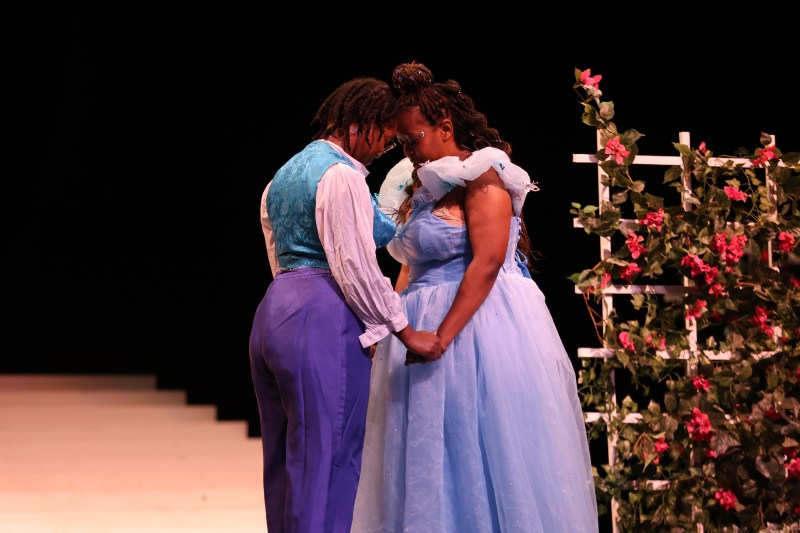Tick-tock-tick-tock, DINNNNG! The clock strikes 12. A glass slipper tumbles down the staircase: click-clack-click. A voice from the palace calls, “Stop that woman!” Suddenly, where there was once a carriage stands a smashed pumpkin, and a woman who once wore a beautiful blue gown is now dressed in rags.
Last weekend BLACKstage brought Memorial Auditorium to life with Rodgers and Hammerstein’s magical musical of “Cinderella.” The production closely followed the classical fairytale, from the evil step-mother and step-sisters to the glass slippers at the ball. However, much like the 1997 film that utilized color-blind casting, BLACKstage utilized an entirely Black cast, shining new meaning on the familiar story.
As someone who grew up watching and loving Disney’s “Cinderella,” it was truly magical to see it enacted in this reimagined fashion.
Sharon Wambu ’24, who played Cinderella, said that “there was so much Black joy” in portraying these characters. Director Liyah Ernest ’26 also highlighted the importance of having a Black cast, since “you don’t get to see a lot of Black people in fairy tales so much.”
BLACKstage took further liberties with the original script in casting a woman (Madison Ambroise ’23) as Prince Christopher, the leading male. This seemed to cause confusion in the audience at first, but it became apparent throughout the rest of the show that Ambroise was still playing a male character. I found it helped to bridge the somewhat uncomfortable power dynamic of the traditional tale, where a powerful rich male effectively saves a lower-class woman from strife.
This was Ambroise’s first and last production at Stanford. She commented on how amazing it was to “put [in] so much time and energy […] and see how much this show grew and changed.” The directors helped her and Wambu “put in real effort and feel really comfortable with the way that we were portraying our roles,” she added.
Several other cast members were new to bringing together a musical. Ernest — who worked as director, set helper and cast member — described the process as a learning experience, expressing appreciation for the “opportunity to take control of things.”
The director’s work with the actors paid off, as the acting and singing were phenomenal. It was clear that they put a lot of work into embodying these characters. The actors’ strong enactments helped them pull off their subversions of traditional gender and race norms, rather than making the changes feel jarring. This effectively reimagined the well-known story arc, flipping the narrative to be more inclusive.
Of course, you cannot have Cinderella without her fairy godmother. I was thoroughly impressed by Nyah Ware’s ’25 performance in this role. Her vocals were phenomenal — she had a unique vocal set with a slight rasp, creating a powerful moment every time she sang. This was most apparent when she sang “Impossible” and “It’s Possible: Finale Act 1.” Her deep, coarse voice beautifully projected the strength and confidence of this all-knowing magical character. It helped her to fit the role of a mentor, teaching Cinderella what she is capable of and to be confident in herself.
If you have seen Disney’s “Cinderella,” you will also be familiar with the somewhat lackluster chemistry between the titular character and the Prince. BLACKstage’s production made these characters much more relatable, giving the audience butterflies in songs like “The Sweetest Sounds,” where Ambroise’s and Wambu’s vocal harmonies blended beautifully together.
The song takes place outside of the village as Cinderella and Prince Christopher — disguised as a peasant — wander in hopes of freedom and an understanding soul. When the two collide, they break into song and confess their search for a true love somewhere out there.
This particular scene also illustrates another highlight of the night: the sets, which swiftly changed throughout to create different rooms and places. The design created a perfect, captivating ambiance for the couple’s first interaction. Vendors and their stands bustled in the background, while the lightning centered on the protagonists.
The pit orchestra also added to the beauty of the performance, creating sounds of magic and allowing for a mystical moment.
Despite these sweet connections, the story could have flowed better. I was left wanting something more, since it has been told and retold multiple times. I was hoping for something to differentiate this iteration’s plot from the rest.
Additionally, there were moments of awkwardness between the interactions of the characters. For instance, some of the romantic scenes between Cinderella and Prince Christopher came off as quirky conveying an odd interaction rather than a cuteness. Overall, though, they certainly dedicated themselves to this performance.
All in all, it was a wonderful experience, creating a sense of childhood wonder and allowing me to revisit a time of magic and glass slippers. As Wambu said, it was a “magical production experience.”
Editor’s Note: This article is a review and contains subjective opinions, thoughts and critiques.
A previous version of this article incorrectly spelled Madison Ambroise’s name. The Daily regrets this error.
